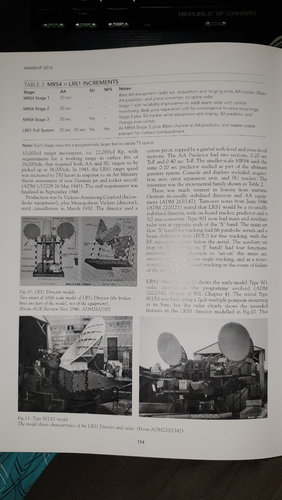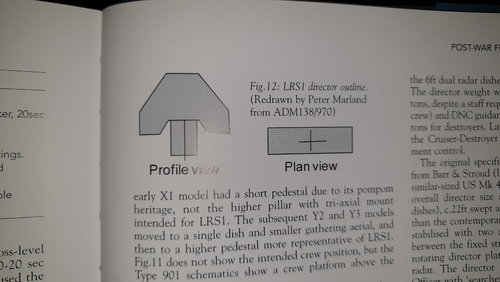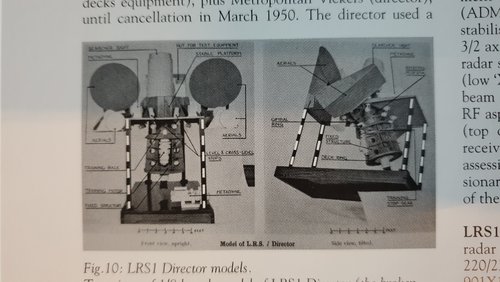You are using an out of date browser. It may not display this or other websites correctly.
You should upgrade or use an alternative browser.
You should upgrade or use an alternative browser.
Sea Slug
- Thread starter zen
- Start date
Dilandu
I'm dissatisfied, which means, I exist.
Does any.material exist describing what.Seaslugs were expected to be fired at?
Initially.Il28 light bombers and Tu16s?
Would a County destroyer be expected to shoot down Migs and Sukhois?
Soviet.stand off missiles were like small jet aircraft well into the 70s.
The initial description of demands to the missile seems to indicate Tu-4 piston bombers.
pathology_doc
ACCESS: Top Secret
- Joined
- 6 June 2008
- Messages
- 1,587
- Reaction score
- 1,510
These were the practice shoots by the ships once 'in service' and are not part of the development of the missile.
Thanks for that clarification. The further information is awaited with eagerness.
Perhaps if we ever invent time travel, we can waylay the people who were taking all the original documents on all this stuff to the shredders and bring it forward in time for preservation? Who here has read Connie Willis's SF time travel novel To Say Nothing Of the Dog? You know the moment I mean.
- Joined
- 27 September 2006
- Messages
- 6,417
- Reaction score
- 6,818
I think for much of its career, Seaslug was well able to cope with Tu16 Badgers and their stand off missiles. Bears and Bisons with pretty big stand offs also. As the Countys were also working with Sea Vixens (till 72) and Phantoms (till 79) it was up to the threat.
Kynda and Kresta 1 were armed with Shaddock SSM. Although not available in large numbers and probably focussed on the UK and US carriers they might have been fired at a County in its role leading a Surface Action Group (SAG) or as part of a NATO force (Stanavforlant or Navcomformed). That might have been too much for Seaslug
Kynda and Kresta 1 were armed with Shaddock SSM. Although not available in large numbers and probably focussed on the UK and US carriers they might have been fired at a County in its role leading a Surface Action Group (SAG) or as part of a NATO force (Stanavforlant or Navcomformed). That might have been too much for Seaslug
Dilandu
I'm dissatisfied, which means, I exist.
Kynda and Kresta 1 were armed with Shaddock SSM. Although not available in large numbers and probably focussed on the UK and US carriers they might have been fired at a County in its role leading a Surface Action Group (SAG) or as part of a NATO force (Stanavforlant or Navcomformed). That might have been too much for Seaslug
Hm. Hard to say. P-6/35 missiles were rather complex for their time, with man-in-the-loop capability to select targets - the missile transmitted the view of its onboard radar to the carrier ship, so operator could discriminate the signatures and lock missile on the correct one. So, she have a good anti-ECM capability, and was reasonably fast. But she could not do any evasive maneuvers, so represented a rather easy incoming target.
Generally, I think, that County could reliably kill one P-35 missile, but definitely not the four-missile salvo.
SeaslugMk2
'Curator' of the Seaslug website.
File AVIA 6/15463 in The National Archives (written in 1949!) identifies potential targets as the equivalent of a Superfortress or Lincoln bomber at 400kts or a single seater fighter-bomber at 600kts. File ADM 220/957 describes trials of manual lock-on procedures for the Type 901 radar using Canberras and Sea Hawks.Does any.material exist describing what.Seaslugs were expected to be fired at?
Initially.Il28 light bombers and Tu16s?
Would a County destroyer be expected to shoot down Migs and Sukhois?
Soviet.stand off missiles were like small jet aircraft well into the 70s.
SRJ.
SeaslugMk2
'Curator' of the Seaslug website.
In the mid eighties I was instructed to destroy all the Seaslug firing reports that we held; I fought a long rearguard action to have them preserved as historical documents but as they were classified as 'secret' no-one could hold them. Ironically at about the same time up at ASWE the Director General Surface Weapons was signing a letter downgrading all Seaslug technical matters to 'restricted' but we were never told that. Sadly I was the person who put those 70-odd ducuments through a shredder; RNAD Ernesettle would also have had copies along with other MoD (Navy) offices, including Branch 35 at Ensleigh. It would be lovely if one of them had preserved a set!These were the practice shoots by the ships once 'in service' and are not part of the development of the missile.
Thanks for that clarification. The further information is awaited with eagerness.
Perhaps if we ever invent time travel, we can waylay the people who were taking all the original documents on all this stuff to the shredders and bring it forward in time for preservation? Who here has read Connie Willis's SF time travel novel To Say Nothing Of the Dog? You know the moment I mean.
SRJ.
Dilandu
I'm dissatisfied, which means, I exist.
If I recall correctly, the Seaslug reload time was about 30+ seconds. The max range of Model II was about 32000 meters. And the P-35 was capable to 350-380 m/s max velocity.
So, assuming that "County"-class destroyer is facing the incoming four P-35 - a typical half-salvo of Kynda-class cruiser (they could launch all eight missile, but have only four control channels, so only four could use man-in-the-loop capability, the others would simply lock on what they see first) - it could engage them from roughly 30 km range. Assuming that missiles are coming head-on, it would means that they needed about 85 seconds to cross the distance (actually close to 70 seconds - because close than 5 km, Seaslug would not be able to reach them).
In that time, Seaslug would be capable of releasing two salvos of two missiles each. The first would made interceptions at 30-25 km, the second - at less than 20-15 km.
So, assuming that "County"-class destroyer is facing the incoming four P-35 - a typical half-salvo of Kynda-class cruiser (they could launch all eight missile, but have only four control channels, so only four could use man-in-the-loop capability, the others would simply lock on what they see first) - it could engage them from roughly 30 km range. Assuming that missiles are coming head-on, it would means that they needed about 85 seconds to cross the distance (actually close to 70 seconds - because close than 5 km, Seaslug would not be able to reach them).
In that time, Seaslug would be capable of releasing two salvos of two missiles each. The first would made interceptions at 30-25 km, the second - at less than 20-15 km.
pathology_doc
ACCESS: Top Secret
- Joined
- 6 June 2008
- Messages
- 1,587
- Reaction score
- 1,510
Ironically at about the same time up at ASWE the Director General Surface Weapons was signing a letter downgrading all Seaslug technical matters to 'restricted' but we were never told that. Sadly I was the person who put those 70-odd ducuments through a shredder
Oh dear. *pats shoulder* You poor bastard, you had no way of knowing. And you did try to hold out for as long as you could.
SeaslugMk2
'Curator' of the Seaslug website.
The NATO standard was originally KH -Target will disintegrate immediately, K -Target will fall out of control within 15 seconds, A -Target will fall out of control within 5 minutes, B -Target will return to base, C -Target's attack will not be completed, and E -Target will be structurally damaged while landing. The USN/missile manufacturers would class all of these as a success (see ADM 1/28039 -TNA) while UK manufacturers would only consider KH and K as successes. UK/US arguments on this resulted in a new NATO standard; K(t) where t is the time taken in seconds for the target to disintegrate. Seaslug, Bloodhound, Firestreak etc., all had to meet K(15).So for the USN a successful firing and hit applies to targets which were forced down or had to retreat but for the RN only those apply which were shot down?
SRJ.
Dilandu
I'm dissatisfied, which means, I exist.
The NATO standard was originally KH -Target will disintegrate immediately, K -Target will fall out of control within 15 seconds, A -Target will fall out of control within 5 minutes, B -Target will return to base, C -Target's attack will not be completed, and E -Target will be structurally damaged while landing. The USN/missile manufacturers would class all of these as a success (see ADM 1/28039 -TNA) while UK manufacturers would only consider KH and K as successes. UK/US arguments on this resulted in a new NATO standard; K(t) where t is the time taken in seconds for the target to disintegrate. Seaslug, Bloodhound, Firestreak etc., all had to meet K(15).
SRJ.
Extremely interesting! Thank you!
- Joined
- 1 February 2011
- Messages
- 2,939
- Reaction score
- 3,624
The NATO standard was originally KH -Target will disintegrate immediately, K -Target will fall out of control within 15 seconds, A -Target will fall out of control within 5 minutes, B -Target will return to base, C -Target's attack will not be completed, and E -Target will be structurally damaged while landing. The USN/missile manufacturers would class all of these as a success (see ADM 1/28039 -TNA) while UK manufacturers would only consider KH and K as successes. UK/US arguments on this resulted in a new NATO standard; K(t) where t is the time taken in seconds for the target to disintegrate. Seaslug, Bloodhound, Firestreak etc., all had to meet K(15).So for the USN a successful firing and hit applies to targets which were forced down or had to retreat but for the RN only those apply which were shot down?
SRJ.
Ahh so this shows in better light (Better kill /hit ratio) the USN missiles then the UK ones. Interesting!
Do we know how the Soviets measured their missile abilities?
SeaslugMk2
'Curator' of the Seaslug website.
Seaslug could only engage one target at a time but a salvo firing with a sufficient interval would allow the interception of two missiles. The second pair would be ready to fire before the first pair had reached the missiles. The shipborne system was designed to allow Seaslugs to be launched in time to complete their interception at maximum range; that range varies with altitude. For a Mk2 missile that is 35,000 yards at sea level, rising to nearly 45,000 yards at 40,000 feet. What is the attack profile for these Soviet missiles?If I recall correctly, the Seaslug reload time was about 30+ seconds. The max range of Model II was about 32000 meters. And the P-35 was capable to 350-380 m/s max velocity.
SRJ.
SeaslugMk2
'Curator' of the Seaslug website.
Don't tell anybody, but I made some notes.....Ironically at about the same time up at ASWE the Director General Surface Weapons was signing a letter downgrading all Seaslug technical matters to 'restricted' but we were never told that. Sadly I was the person who put those 70-odd ducuments through a shredder
Oh dear. *pats shoulder* You poor bastard, you had no way of knowing. And you did try to hold out for as long as you could.
SRJ.
Dilandu
I'm dissatisfied, which means, I exist.
What is the attack profile for these Soviet missiles?
The P-35 came toward target at 400-7000 meters altitude (depend on firing range; the higher the missile climbed, the more range it have). Missile seeker was able to track & lock on targets from roughly 20 km range.
After locking on target, missile descended to 100 meters, and made terminal approach. Initially, missile guided itself only on yaw axis (horizontally), the altitude was locked. When the target was close enough, missile started to guide both on yaw and pitch (both horizontally and vertically), making the attack run in shallow dive.
When used against stationary targets - such as coastal installations - missile climbed to max altitude and dived on target nearly-vertically.
- Joined
- 1 February 2011
- Messages
- 2,939
- Reaction score
- 3,624
I have a question regarding the Type 901 radar associated with the GWS.1 Sea Slug Missile.
I know from the various books and sources that it was evolved from the LRS.1 Director/Radar system's Type 901X radar.
But how did it became from a gunnery smaller twin/quadruple dish radar system to a single drum or bucket shaped radar?
The few photos and sketch drawings (Will post them later I don't have the images at me now) I've made this drawing of the LRS.1:

but which was often depicted as a sort of trapezoid equipment:

Then the first sketch of the radar intended for the Sea Slug in the 1948/49 cruiser series shows one large dish accompanied by three smaller ones:

but by the early/mid 1950's in the GW series the radar sketch shows it's final bucket like form:

I know from the various books and sources that it was evolved from the LRS.1 Director/Radar system's Type 901X radar.
But how did it became from a gunnery smaller twin/quadruple dish radar system to a single drum or bucket shaped radar?
The few photos and sketch drawings (Will post them later I don't have the images at me now) I've made this drawing of the LRS.1:

but which was often depicted as a sort of trapezoid equipment:
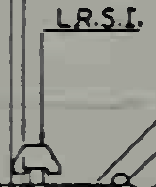
Then the first sketch of the radar intended for the Sea Slug in the 1948/49 cruiser series shows one large dish accompanied by three smaller ones:
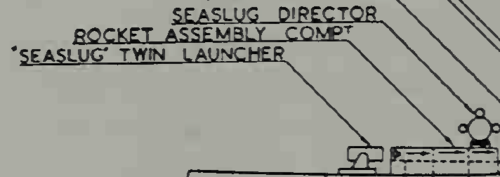
but by the early/mid 1950's in the GW series the radar sketch shows it's final bucket like form:
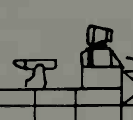
Dilandu
I'm dissatisfied, which means, I exist.
But how did it became from a gunnery smaller twin/quadruple dish radar system to a single drum or bucket shaped radar?
I knew only about technical reasons; the RN wanted the missile to lead the target, not merely chase it, but the one-dish conical scanning radar could not do that. So, they tried twin dish (one constantly tracked the target, other provided guidance beam for missile), and then realized that it's actually possible to combine target tracking with the missile direction using the wider bucket-shape antenna.
SeaslugMk2
'Curator' of the Seaslug website.
The tracking and guidance beams are co-axial; the spinners are back to back and both are focused by the dialectric lens of the type 901. The gathering antenna is a small parabolic dish set to one side. In the LRS systems one antenna was for target tracking and the second was to gather the target.
SRJ.
SRJ.
- Joined
- 1 February 2011
- Messages
- 2,939
- Reaction score
- 3,624
The tracking and guidance beams are co-axial; the spinners are back to back and both are focused by the dialectric lens of the type 901. The gathering antenna is a small parabolic dish set to one side. In the LRS systems one antenna was for target tracking and the second was to gather the target.
SRJ.
And this was what they had mind in the 1948 proposal? The one large central dish surrounded by 2-3 smaller ones?
SeaslugMk2
'Curator' of the Seaslug website.
As far as I remember (unfortunately I lost the photos from the TNA files in a disk crash) the LRS had settled down to a pair of reflectors on a pom-pom mount, one for tracking and one to gather the tracking beam onto the target. Both started as paraboloids but ended up more cylindrical in shape -similar to the Blindfire units used with Rapier. There were a number of suggested scanning patterns for the gathering unit, for example flower-petal and a raster scan; but there was a statement in the files that the gathering unit should be able to change to a horizontal scan 'by a change of gears' to allow it to be used for shell-splash spotting in its surface-to-surface role!
SRJ.
SRJ.
SeaslugMk2
'Curator' of the Seaslug website.
I recognise the photos at the bottom of the first picture, there were many versions of the LRS1 as well as Type 901 though.
SRJ.
SRJ.
RHVERNON
I really should change my personal text
- Joined
- 8 October 2016
- Messages
- 19
- Reaction score
- 64
Of the remaining 62 firings 25 were classed as unsuccessful and 37 as successful,
Out of interest, what is the definition of a successful firing? Destruction of the target is of course unequivocal, but were there "softer" criteria in some or all of the firings? Inquiring minds want to know what they were looking for and why they were looking for it.
(I remember reading a case of a Fireflash ripping its wings off when the boosters separated, but the control actuators still steering it to a kill. Success and failure in the one shot!)
In other words, are these all live firing practice, or do they include experimental and/or development shots?
All of the British SAM's and AAM's were designed to get a K Kill as standard. The principle roll of acceptance trials done at Woomera were to proof mathematical models of the missile performance against specific types of targets (Jindavik, Meteor and Canberra) that could be used to predict its effectiveness against different Soviet aircraft. The reasons for the use of three different targets were to do with Radar Cross Sections, Altitude limits of the aircraft and RF thermal noise generated by the engines (Viper = quite, Derwent = medium, Avon = noisy) The other role was to proof modifications that had came out from earlier firings during the acceptance trials. The later Service Firings were against ECM systems not available at Woomera or test things like capability against a supersonic target when the Stiletto drone became available . Modification proofing and straight out training firings for the users were also the norm. though the latter two could be done together and usually was. Did missiles fail and successfully hit the target?? Bloodhound did it at least twice! First time was a Mk 1 Service Firing at Aberporth (I can't remember the missile number or Squadron that prepared and fired it, but the Squadron Operational Record book recorded everything that went wrong up to the point that the missile broke up just as it reached the target and hit it). The second was a Missile Evaluation Trial Bloodhound Mk 2 round (S-108) fired by 15 JSTU at Woomera in 1963. The film of the intercept of a Meteor is at around 3.20 on this youtube video link below. The missile was a low level, minimum range shot and the missile lost the tip of a wing, that then hit the tailplane and ripped the whole thing off. As you can dee the rapidly rolling missile then hit the wing of the Meteor. Some Slug footage on here as well.
- Joined
- 27 May 2008
- Messages
- 1,178
- Reaction score
- 2,483
Seeing the Bloodhound losing a wing just prior to impact may confirm one thing I remember being told. The story went something like this;- With the twin ramjet arrangement there was the risk that when pitching, the turbulent air separating from the fore-body would kill the vital shockwave on the upper engine. Hence the autopilot was set up to do relatively gentle twist and steer so as to not to snub out the ramjet. In the early days of trials this gave excessive miss distances..... unacceptable. The solution was to measure the distance traveled towards the target (Using Doppler?) and then when in the last couple of seconds, switch the control logic to use aggressive control surface deflection(full travel at max rate), irrespective of this upsetIng the ramjet (or even overload the airframe) . This did the trick and collisions became the norm. And the invention of automatic adaptive control systems has been widely credited to the 80’s.
Last edited:
SeaslugMk2
'Curator' of the Seaslug website.
Seaslug had something similar; a pitot tube in the nose assessed the air pressure to limit the guidance receiver's output so as to ensure small control surface movements in 'dense' low altitude air and at high speeds;similarly there were motor-driven potentiometers that slowly reduced resistances during the missile's flight. When the 'arm' command was given (at 1000 yards-to-go) these were both shorted out so that the missile would respond quickly and not miss the target.
SRJ.
SRJ.
Maury Markowitz
From the Great White North!
- Joined
- 27 February 2014
- Messages
- 192
- Reaction score
- 144
As noted in various sources, the issue was that the resulting "stack" length presented significant problems for shipboard handling, and especially below-deck handling and storage. During the design, it was noted that a ready-stack of missiles prepared to be pushed onto the launcher would demand much more internal preparation area. The wrap-around boosters were designed to lie within the span of the fins and thus not actually expand the footprint of the missile beyond what was already needed on the dollies.I had understood that Seaslug got the wrap-around boosters because Farnborough (?) thought that tandem boosters would be vulnerable to shock.
The boosters were originally positioned at the rear, like Thunderbird, and there is an image in the wiki article showing this arrangement during an early launch from Girdle Ness. But concerns about variable burn rates and thus asymmetric thrust led to them being moved forward to be closer to the CoG where any such effect would not overwhelm the authority of rear-mounted control surfaces even at low speeds immediately after launch.
According to the histories I've read, there was some degree of the opposite argument going around. With Sea Slug still being under development, there was push-back on the idea of starting another missile development at the same time, especially as there was widespread concern it would be delayed in the same way. However, the dramatically increased performance of the proposal eventually won the argument that this could be considered more of a fighter-cover replacement than a defensive weapon like Sea Slug. This led to the (somewhat questionable IMHO) claims of its performance relative to F-4's.My impression is that by about 1959, when what became Sea Dart was being proposed, many in the British defense bureaucracy were heartily sick of the high developmental cost and delay associated with Seaslug, and wanted something -- anything -- else. Sea Dart was pushed as something entirely different, not a Seaslug replacement (which it was).
The concern was not size or cost per se, but that the crew requirements of a larger ship, combined with the manpower limits imposed on the Navy, resulted in a choice between more smaller ships or fewer larger ones. As the Navy's thinking changed from being 100% focussed on a war against the SU in the north Atlantic to being more heavily involved with worldwide force projection and bushfire wars, the small number of larger designs would present the problem that some task forces would lack cover. Thus the smaller designs immediately took over planning. The various books on the County class go into significant detail on these back-n-forth arguments.It did not help that the Admiralty insisted on cutting the size of the Seaslug ship because it equated size with cost -- the designers were aware that everyone else's missile ships were rather larger.
What is known about the fuel used in Sea Slug?
I've been researching RNPF (later RAF now MoD) Caerwent and believe the fuel was produced there as the factories final hurrah. Is there any proff of this other than family stories about my late grandfather who was a scientist at the base?
I've been researching RNPF (later RAF now MoD) Caerwent and believe the fuel was produced there as the factories final hurrah. Is there any proff of this other than family stories about my late grandfather who was a scientist at the base?
SeaslugMk2
'Curator' of the Seaslug website.
I'm not sure about the fuel used for the Gosling and Foxhound motors in the Mk1 missiles -cordite based, perhaps? The Retriever and Deerhound motors used a cast double-base propellant which involved the motor being filled with a powder and having nitroglycerine pumped in and left to cure under pressure. I understood this work was done at IMI's works at Kidderminster but Caerwent may have produced the powder and/or nitroglycerine. Certainly they refilled a set of Retriever motors for Chile when they bought three of the County class destroyers.
SRJ.
SRJ.
- Joined
- 26 May 2011
- Messages
- 2,318
- Reaction score
- 3,472
There's a file in Kew that has cross-sectional drawings and data on early UK rocket motors. I've had a look on my hard drive, but I think I pulled it before cameras were allowed.
I do have the following:
Foxhound - Slotted radial Cast Double Base E512
Foxhound 2 - Slotted radial Cast Double Base E528
Gosling I - Extruded Double Base
Gosling III, V and XVIII - Composite
Can't claim to know what any of this means!
Chris
I do have the following:
Foxhound - Slotted radial Cast Double Base E512
Foxhound 2 - Slotted radial Cast Double Base E528
Gosling I - Extruded Double Base
Gosling III, V and XVIII - Composite
Can't claim to know what any of this means!
Chris
- Joined
- 27 May 2008
- Messages
- 1,178
- Reaction score
- 2,483
Cordite is 52- 65% Nitrocellulose (NC), 30-42% Nitroglycerin(NG) and 5-6 %Petroleum Jelly(PJ). It was developed as a smokeless ammunition propellant but later adapted as a rocket propellant. The PJ was added to optimised its extrusion so as to allow easy shell case filling but this same process could be used to produce a motor charge (Aka grain) that use inserted into a tube ie Gosling.
It was quickly found that if the PJ was dropped from the formulation and the remaining two parts were brought together in a different process such as powder casting, then the specific impulse (“isp” a measure of it power to weight) could be improved. This was called “Double -base“. With care the formulation could work reliably up to 50:50 but was impossible to tame with an NG content above this. Really clever things were used even at the ratio, such as rods, which if excessively heated would release a quantity of flame extinguisher to damp the reaction rate down (used in the Talos Booster)
Composite propellant uses an oxygen rich salt and a metal powder bound together with a small fraction of an adhesive. Typically the oxidiser is ammonium perchlorate, the metal is aluminium and binder is HTPB which is a rubberised polyurethane. These generally gave better isp’s but couldn’t match the burn rate of a 50:50 D-b.
There’s also a bunch of other combinations such as the introduction of aluminium powder into D-b, powdered explosive into the composite propellant , designs which transition between a D-b and composite, to name a few.
Gosling in its original version was first generation and hence was primitive compared to what followed.
It was quickly found that if the PJ was dropped from the formulation and the remaining two parts were brought together in a different process such as powder casting, then the specific impulse (“isp” a measure of it power to weight) could be improved. This was called “Double -base“. With care the formulation could work reliably up to 50:50 but was impossible to tame with an NG content above this. Really clever things were used even at the ratio, such as rods, which if excessively heated would release a quantity of flame extinguisher to damp the reaction rate down (used in the Talos Booster)
Composite propellant uses an oxygen rich salt and a metal powder bound together with a small fraction of an adhesive. Typically the oxidiser is ammonium perchlorate, the metal is aluminium and binder is HTPB which is a rubberised polyurethane. These generally gave better isp’s but couldn’t match the burn rate of a 50:50 D-b.
There’s also a bunch of other combinations such as the introduction of aluminium powder into D-b, powdered explosive into the composite propellant , designs which transition between a D-b and composite, to name a few.
Gosling in its original version was first generation and hence was primitive compared to what followed.
Last edited:
- Joined
- 15 July 2007
- Messages
- 4,887
- Reaction score
- 4,552
Back to history.
Conceived possibly as early as '43.
Firm design expected '46.
team transferred from Westcott to Farnborough (resisted to the point some refused to move).
Scheduled for Service in 1956.
Virtual stop '48.
Tested 1958 aboard Girdleness (prototyping Escort)
By '48 described as 20ft long bi-fuelled missile 16" diameter, 4ft 10" wingspan, with boosters.
Hopes of developing to a 15ft long 12" diameter, 3ft 7" wingspan missile.
Jan '48 assessment that guidance couldn't be determined for at least another two years.
Solution AW work on mkII for interim while work on mkIII optimum system.
Dimensions set 1950, but estimation was thrown awry by the shift to solid fuel motor.
It's the length changes that help explain the final design, launcher and handling system.
Conceived possibly as early as '43.
Firm design expected '46.
team transferred from Westcott to Farnborough (resisted to the point some refused to move).
Scheduled for Service in 1956.
Virtual stop '48.
Tested 1958 aboard Girdleness (prototyping Escort)
By '48 described as 20ft long bi-fuelled missile 16" diameter, 4ft 10" wingspan, with boosters.
Hopes of developing to a 15ft long 12" diameter, 3ft 7" wingspan missile.
Jan '48 assessment that guidance couldn't be determined for at least another two years.
Solution AW work on mkII for interim while work on mkIII optimum system.
Dimensions set 1950, but estimation was thrown awry by the shift to solid fuel motor.
It's the length changes that help explain the final design, launcher and handling system.
Dilandu
I'm dissatisfied, which means, I exist.
A question: was Sea Slug ever actually tested against surface target?
(just have a discussion on Russian "Warhead" site, about the possibility of "County"-class destroyer battling "General Belgrano" in 1982).
(just have a discussion on Russian "Warhead" site, about the possibility of "County"-class destroyer battling "General Belgrano" in 1982).
SeaslugMk2
'Curator' of the Seaslug website.
Yes, it made a real mess of HMS Venus (a target ship!) but I think that was the only surface target it hit. Aircraft targets below 1000 feet were fairly safe too.
SRJ.
SRJ.
- Joined
- 1 February 2011
- Messages
- 2,939
- Reaction score
- 3,624
According to this:
 www.iwm.org.uk
www.iwm.org.uk
That was a Seaslug Mk II launched from HMS Glamorgan:
Collection: DERA ABERPORTH
Black and white negatives and 35mm colour transparencies generated or collected by DERA Aberporth weapons research establishment in Wales relating to the development of various British rockets and missiles during 1945 - 1968 at the height of the Cold War. Including:Negative Ref...
That was a Seaslug Mk II launched from HMS Glamorgan:
4923 Met Ship - copy neg of aerial shot of the ship Weather Advisor. 4928/2-12 Damaged sea target Venus Shows the target ship F50 (ex HMS Venus) with bows shot off. Records show that a Seaslug 2 missile fired from HMS Glamorgan on 16 February 1968 achieved a direct hit on Venus.
SeaslugMk2
'Curator' of the Seaslug website.
There is a reference to this in one of the files that deals with Sea Dart trials against surface targets; HMS Venus was one of them. It mentions that Venus took quite a while to be repaired after the Seaslug hit it!According to this:
Collection: DERA ABERPORTH
Black and white negatives and 35mm colour transparencies generated or collected by DERA Aberporth weapons research establishment in Wales relating to the development of various British rockets and missiles during 1945 - 1968 at the height of the Cold War. Including:Negative Ref...www.iwm.org.uk
That was a Seaslug Mk II launched from HMS Glamorgan:
4923 Met Ship - copy neg of aerial shot of the ship Weather Advisor. 4928/2-12 Damaged sea target Venus Shows the target ship F50 (ex HMS Venus) with bows shot off. Records show that a Seaslug 2 missile fired from HMS Glamorgan on 16 February 1968 achieved a direct hit on Venus.
SRJ.
Dilandu
I'm dissatisfied, which means, I exist.
Yes, it made a real mess of HMS Venus (a target ship!) but I think that was the only surface target it hit. Aircraft targets below 1000 feet were fairly safe too.
SRJ.
Thank you for information!
- Joined
- 1 February 2011
- Messages
- 2,939
- Reaction score
- 3,624
Having the Counties a single Type 901 Radar direct but a twin launcher, would it be logical to load two missiles at once and launch the first and launch the second as soon as the first on terminal trajectory? Or could the Type 901 direct two missiles on the same target?
Dilandu
I'm dissatisfied, which means, I exist.
Having the Counties a single Type 901 Radar direct but a twin launcher, would it be logical to load two missiles at once and launch the first and launch the second as soon as the first on terminal trajectory? Or could the Type 901 direct two missiles on the same target?
In theory, it could direct any number of missiles. The Sea Slug was a beam-rider, so essentially the radar just provided the beam - and missiles maintain themselves in beam autonomously. At least in simplest, Line-Of-Sight method.
On practice, some guidance methods for Sea Slug required additional commands transmitted. Like CASWTD (Constant Angle of Sight with Terminal Dive) required "dive" command, and Up And Over required "glide" command. I do not know, were those commands personalized to each missile, or just transmitted for all missiles in beam simultaneously.
So the basic interception of high-flying target could be made with any number of missiles riding the same beam - at least, theoretically - but not more complex.
SeaslugMk2
'Curator' of the Seaslug website.
The system could cope with two missiles in the beam (by designating them 'left' and 'right') so that they could be given individual 'arm' and 'detonate' commands; the Mk2 also had the dive/glide command. Extra missiles in the beam would react to commands to earlier missiles so no, only two at a time. The salvo separation was six seconds, and the computer only required a couple of seconds between salvoes -a reset time between 'end of engagement' and another salvo.

